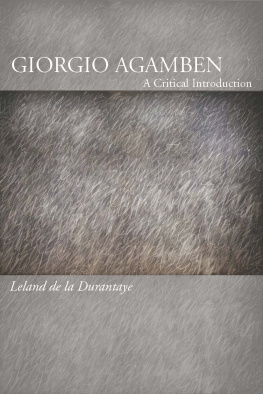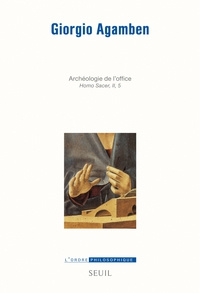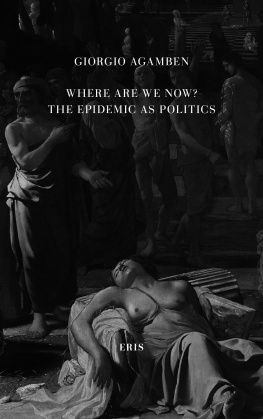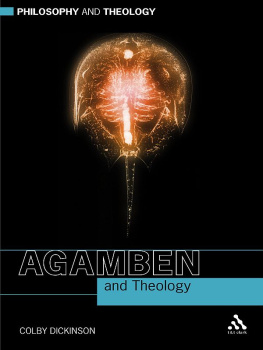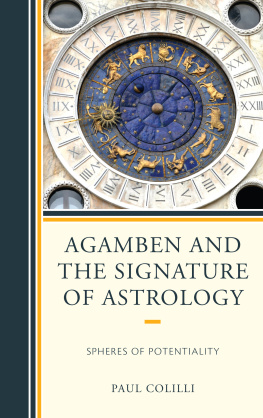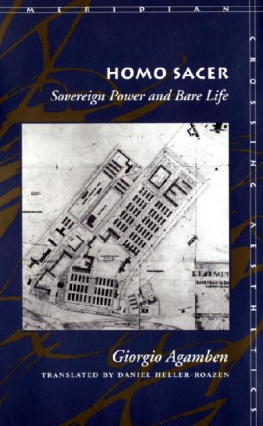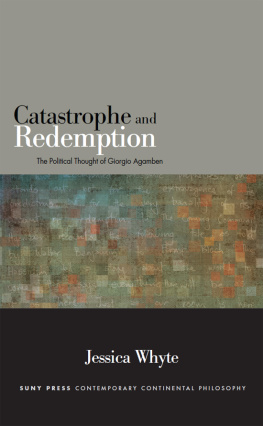de la Durantaye - Giorgio Agamben: a Critical Introduction
Here you can read online de la Durantaye - Giorgio Agamben: a Critical Introduction full text of the book (entire story) in english for free. Download pdf and epub, get meaning, cover and reviews about this ebook. City: Palo Alto, year: 2009, publisher: Stanford University Press, genre: Science. Description of the work, (preface) as well as reviews are available. Best literature library LitArk.com created for fans of good reading and offers a wide selection of genres:
Romance novel
Science fiction
Adventure
Detective
Science
History
Home and family
Prose
Art
Politics
Computer
Non-fiction
Religion
Business
Children
Humor
Choose a favorite category and find really read worthwhile books. Enjoy immersion in the world of imagination, feel the emotions of the characters or learn something new for yourself, make an fascinating discovery.
- Book:Giorgio Agamben: a Critical Introduction
- Author:
- Publisher:Stanford University Press
- Genre:
- Year:2009
- City:Palo Alto
- Rating:3 / 5
- Favourites:Add to favourites
- Your mark:
- 60
- 1
- 2
- 3
- 4
- 5
Giorgio Agamben: a Critical Introduction: summary, description and annotation
We offer to read an annotation, description, summary or preface (depends on what the author of the book "Giorgio Agamben: a Critical Introduction" wrote himself). If you haven't found the necessary information about the book — write in the comments, we will try to find it.
Abstract: A critical introduction to the work of the Italian philosopher Giorgio Agamben
Giorgio Agamben: a Critical Introduction — read online for free the complete book (whole text) full work
Below is the text of the book, divided by pages. System saving the place of the last page read, allows you to conveniently read the book "Giorgio Agamben: a Critical Introduction" online for free, without having to search again every time where you left off. Put a bookmark, and you can go to the page where you finished reading at any time.
Font size:
Interval:
Bookmark:

My first thanks go to the subject of this study for the teaching and works that led to it. I thank Jonathan Culler for kind assistance and advice. I thank Cesare Casarino for introducing me to Agambens writings. Jen Hui Bon Hoa and John Minervini read large unruly swaths of the manuscript in its early stages and whatever clarity those sections have attained is thanks to their efforts. I thank Moira Gallagher for her careful reading of several chapters. I thank Doug Lavin for eleventh-hour assistance with the function of mankind.
I thank Norris Pope at Stanford University Press for his interest in the project from inception to completion, and his colleagues Alice Rowan, Sarah Crane Newman, Emily-Jane Cohen, and Tim Roberts for their editing of the final product. Warm thanks go to my colleagues in the Departments of English and Comparative Literature at Harvard University for kindnesses too many and too diverse to name. I thank the faculty, fellows, and staff of Princeton Universitys Laurance S. Rockefeller Center for Human Values for their recommendations concerning Chapter Seven of this study. I thank Thomas Khurana and his colleauges at the University of Potsdam for their insightful discussion of Chapter Five. I thank Nicola del Roscio for his permission to reprint the image featured on this books cover. Finally, I thank the staffs of the American Academy in Rome, the Biblioteca nazionale centrale di Roma, the Bibliotheque Nationale de France, the Bibliotheque de lcole Normale Suprieure, the Staatsbibliothek in Berlin, and the libraries of Harvard University for access to their collections and help finding my way in them.
In a preface to one of his works, Agamben remarked that every written work can be regarded as the preface (or rather, the broken cast) of a work never written, and that of necessity remains so because in relation to it later works (in turn prefaces or moulds for other absent works) represent but sketches or death masks (IH, 3 [vii]). Elsewhere he has noted that in a certain sense my books are in reality but a single book which is, in turn, nothing but a sort of preface to a work never written, and impossible to write (UIGA, 33). At first sight these characterizations of every completed work as but a preface to an unwritten one might seem to express a sense of the unattainability of aspirations. As becomes clear to Agambens reader, however, he has a very different idea in mind.
Agambens remarks on the secret life of prefaces and books reflect an important idea for himthe idea of incompletion. At issue here are not merely the obstacles that stand in the way of individual creations, and Agamben does not mean that authors always undershoot their mark or overestimate their capacities, nor is he referring to the external factors that prevent a work from attaining the fullness it might have achieved had not greedy wine merchants, harrying tailors, and eloquent panderers distracted the great minds from their tasks. What he is trying to elucidate through his remarks on incompletion is something stranger and more elusive: his idea of the work.
Although he nowhere indicates this, in his earlier remark Agamben is practicing an art he has long masteredBenjamins art of citing without quotation marks. In a letter to Florens Christian Rang from January 10, 1924, the young Benjamin wrote that a consideration of the relation between the work and its first inspiration ... leads me to the conclusion that every completed work is the death-mask of its intuition (Benjamin GB, 2.406). Four years later Benjamin returned to this singular image in a section of his One-Way Street entitled The Writers Technique in Thirteen Theses. The thirteenth and final thesis therein reads: The work is the death-mask of conception (Benjamin GS, 4.107). In Benjamins image, the work appears as a rigid and lifeless formnot life, but its imprint. Given Agambens impassioned familiarity with Benjamins work, there can be little doubt that he had this image in mind when he wrote the passages cited above, just as there can be no doubt that the image carries a special significance for him. The question remains, however, as to why the idea of the completed work should conjure such dark associations for the two writers.
Benjamins image associates completion with death, and what is alive, by contrast, is the conceiving and creating of a work. For Benjamin there is a melancholic note to be heard at the end of any work, as at the end of any enlivening experience. But the figure here is not only that of a creator taking leave of a cherished creation; it also involves leaving the limitless realm of potentiality for the confines of actuality. Benjamins image consigns every completed work to in completion, but as we saw, the manner in which he understands such incompletion is idiosyncratic. In his final, and unfinished, work, he claimed that, remembrance can make the incomplete (happiness) complete, and the complete (pain) incomplete (Benjamin GS, 5.589). In this surprising reversal of categories, it is the completefrozen in placethat Benjamin equates with pain, whereas happiness is found under the more mobile sign of the in complete.
This reversal lends Benjamins idea of prose its singular form. In a fragment that gave Agambens fifth book its title, Benjamin states that the messianic world is the world of complete and integral actuality. In such a world, Benjamin writes, history is not written: it is celebrated as a festival. As a purified festival, however, it does not have the character of a ceremony and knows no hymns. Its language is a freed prose, a prose that has broken the chains of writing (Benjamin GS, 1.1235). This festive life is one where the division between sacred and profane no longer has any meaning and is without rite because there is no longer anything to separate the two spheres; it is the festivity of a life where all illuminations are profane. Such a world no longer waits for any transcendental consecration or culmination and what it celebrates it celebrates simply, every moment of every day. The language it employs is, from our perspective, an inconceivable one: a freed prose that has broken the chains of writing. To break the chains of writing can only mean to free the written work from its frozen formor in other words, to experience it in all its potentiality. In an essay that gave its title to a collection of Agambens essays, The Potentiality of Thought, he reminds his reader of the most demanding and inescapable experience possible: the experience of potentiality; and it is precisely this experience that the completion of a work offers (P, 178 [274], translation modified).
As we saw earlier, Agamben took Benjamins ideas about incompletion and happiness with the utmost seriousness. Showing perceptible admiration, Agamben cited Vasaris remark about Leonardo da Vinci that, thanks to his intelligence in the arts, he started many projects, and finished none (LDV). Yet the idea of incompletion that so occupies Agamben clearly extends beyond questions of the actual completion of individual works. In the poem Clearings, Agamben evokes how all in us / remains incomplete, and in the opening words of an essay published a year earlierin 1966he remarked that it is to be doubted whether the concept of the work is even conceivable in unambiguous fashion (R, 53; PB, 42). Rather than impatience with the act of writing or eagerness to move on from one project to the next, this idea reflects first and foremost Agambens interest in all that the completed form of a work cannot bring into its closed confines. In short, for Agamben, the idea of incompletion is inseparable from the idea of the work.
Font size:
Interval:
Bookmark:
Similar books «Giorgio Agamben: a Critical Introduction»
Look at similar books to Giorgio Agamben: a Critical Introduction. We have selected literature similar in name and meaning in the hope of providing readers with more options to find new, interesting, not yet read works.
Discussion, reviews of the book Giorgio Agamben: a Critical Introduction and just readers' own opinions. Leave your comments, write what you think about the work, its meaning or the main characters. Specify what exactly you liked and what you didn't like, and why you think so.

